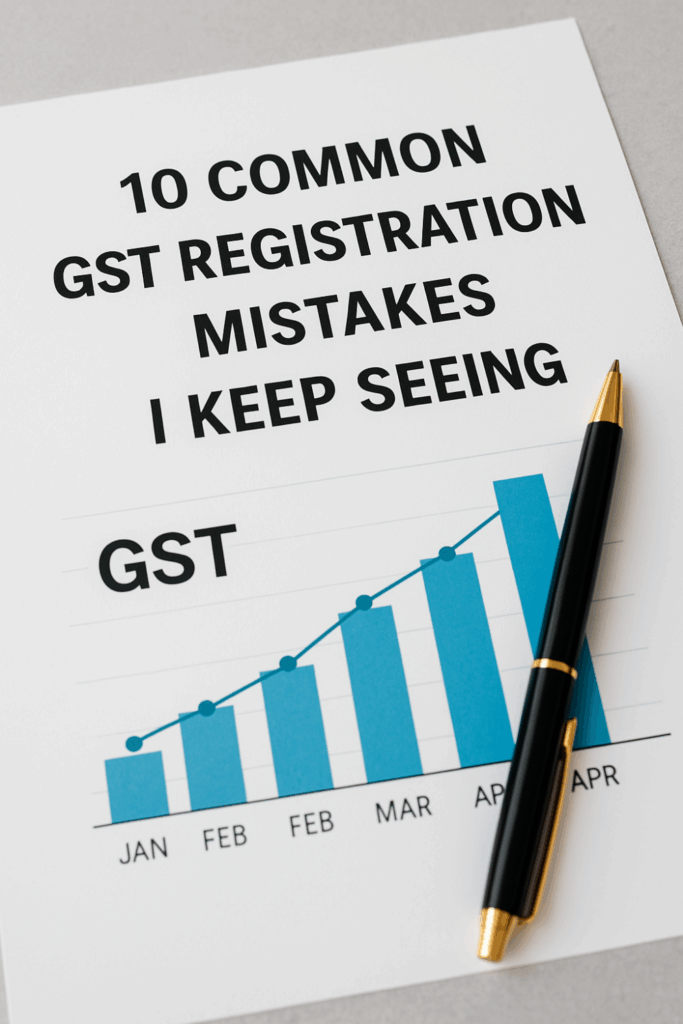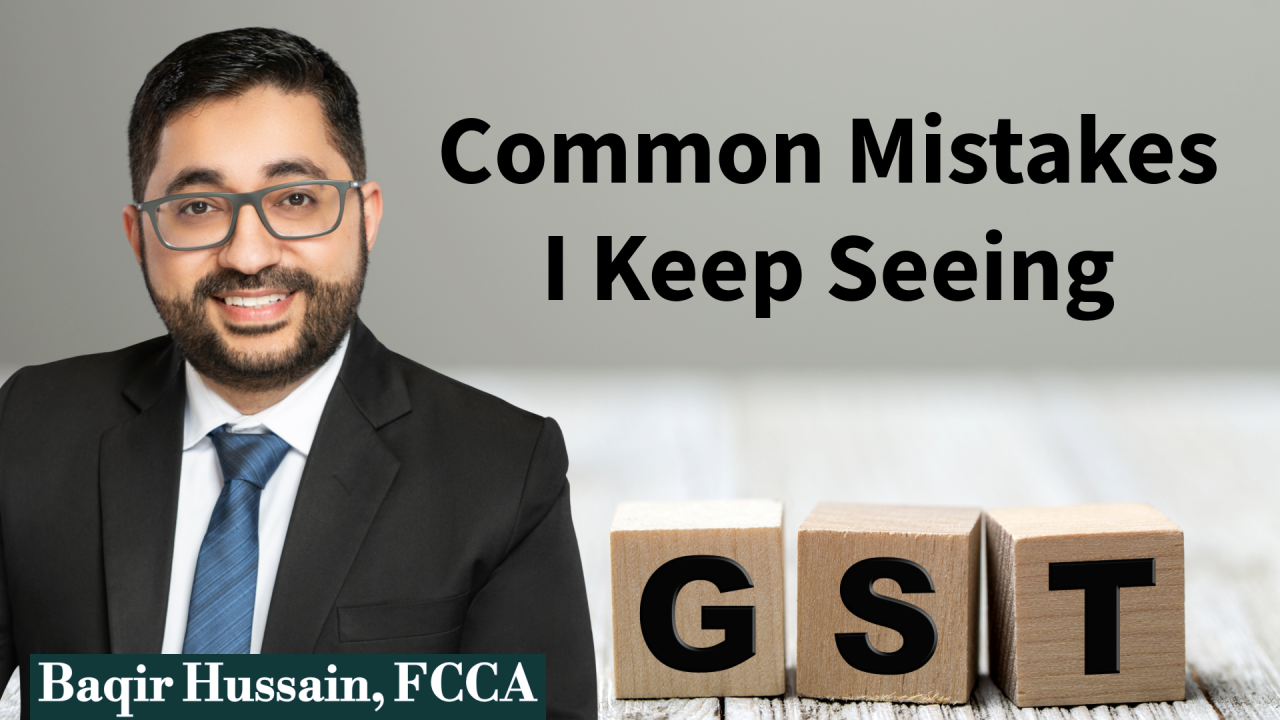When it comes to GST registration in New Zealand, I keep seeing the same mistakes, even from established businesses that have been operating for years.
Over the years, I’ve dealt with these issues countless times, across businesses of all sizes. From start-ups to seasoned operators.
Quick note: If you’d like a simple way to check where your GST setup stands while you read, grab my free GST Registration Checklist. It’ll help you review each area as we go through the most common mistakes.
In this article, I’ll share
- What GST actually is and how it works
- Top 10 most common GST registration mistakes
- Why these mistakes can hurt your business
- How to avoid each mistake.
- My personal advice

What is GST?
GST stands for Goods and Services Tax, and in New Zealand it’s set at 15%. It’s a tax added to the price of most goods and services you buy or sell.
Most everyday purchases include GST in the price — but some things don’t. Common examples include:
- Rent on the house or flat you live in (but GST applies if you rent a holiday home)
- Airfares for overseas travel
- Mortgage payments
- Bank fees or charges
Businesses registered for GST collect it from their customers and pass it on to IRD, while also claiming back GST on their own expenses.
How the Mistakes Are Structured
To make it easier to follow, I’ve grouped the mistakes into three key stages of the GST journey:
- Setup: Getting your GST registration right from the start
- Operational: Managing your GST registration correctly day-to-day
- Closure: Wrapping your GST registration up properly when your business stops trading
Phase 1: Getting GST Registration Right (Setup Stage)
1. Not Knowing What GST Is (and Isn’t)
GST is not your income, and it’s not your expense. It’s money you’re temporarily holding on behalf of IRD.
When a buyer pays GST to a seller, the seller simply collects it and passes it on to IRD. In a sense, you’re working for IRD as an unofficial agent every time you charge GST.
Why it matters
Confusing GST with business income often leads to cashflow problems. Business owners spend GST they should have set aside for IRD.
2. Not Registering with the IRD
I often hear from from start-ups thinking that they don’t need to register because their turnover is below the $60k threshold. But if your prices include GST (for example, commercial leases or taxi fares). You must register even if your income is under the threshold.
Registration is mandatory if:
- Your annual turnover exceeds $60,000, or
- If your prices include GST.
Why It Matters
Failing to register when required can lead to back-dated GST liabilities, penalties, and interest. IRD won’t accept “I didn’t know” as an excuse.
3. Late registration
IRD only approves backdated GST registration in exceptional circumstances. Delays can cost you dearly.
If you make major purchases (like tools, vehicles, or equipment) before registering, you may miss out on the GST refunds on those costs if IRD doesn’t approve a backdate.
Why it matters
It hurts your cashflow and working capital. Late registration can permanently reduce your available input credits, and you’ll still have to pay output GST once registered.
4. Charging and Collecting GST When you’re Not Registered
If you’re not registered for GST, you cannot charge or collect GST from your customers or include it on your invoices.
This is one of the most serious mistakes in IRD’s eyes. Businesses often do this simply because they don’t fully understand how GST works.
If you’ve accidentally charged GST without being registered, speak to a tax agent immediately to correct it.
Why it matters
IRD treats this as false representation, and you can be required to repay the collected GST plus penalties.
Phase 2: Managing GST Correctly (Operational Stage)
5. Choosing the Wrong Accounting Basis
There are three ways to account for GST: payments, invoice or hybrid basis.
For most small businesses starting out, the payments basis works best because you only pay GST after receiving payment from customers. Once your annual revenue exceeds $2 million, you must move to the invoice or hybrid basis.
Why it matters
Choosing the wrong basis can distort cashflow. You might end up paying GST on sales you haven’t been paid for yet.
6. Selecting the Wrong Filing frequency
You can file GST monthly, two-monthly, or six-monthly.
Six-monthly sounds easier, but often leads to big debts piling up. Two-monthly filing suits most businesses. It strikes a good balance between admin and cashflow. Monthly filing works if you want to stay ultra-current (or don’t like money siting in your account owed to IRD).
Why it matters
The longer you wait between filings, the higher the risk of spending GST funds you don’t actually own.
7. Misaligned Filing Periods
If you file GST six-monthly, make sure your filing periods align with March and September.
If you pick random months, your GST filing periods won’t match the standard financial tax year-end, creating extra reconciliation work for your accountant and more cost to you.
Why it matters
Misalignment causes confusion, timing differences, and unnecessary accounting costs at year-end.
8. Not Reviewing Your GST Setup as You Grow
As your business scales, your eligibility for filing frequency and accounting basis changes.
Once your turnover exceeds $500k, you can’t file six-monthly. Once you hit $2m, you can’t stay on the payments basis. Many established businesses forget to review these settings.
Why it matters
Operating on the wrong settings puts you out of compliance and may trigger IRD reviews or forced adjustments.
Phase 3: Wrapping Up (Closure Stage)
9. Not Deregistering When Business Stops
If you stop trading but don’t formally deregister, IRD still expects GST returns every filing cycle.
Many business owners think they can simply stop filing. IRD doesn’t see it that way.
Why it matters
You’ll keep receiving IRD reminders, late-filing penalties, and eventually debt collection notices for a business that no longer trades.
10. Forgetting the Final GST Return
Even after you deregister, you must file one last GST return and make any final adjustments.
For example, if you claimed GST on a vehicle or equipment you’re keeping, you’ll need to return part of that GST to IRD.
Why it matters
Missing this step means your deregistration isn’t complete, and IRD can reopen your GST account later.
My Personal Advice
I come across these GST mistakes almost every week, and it still surprises me how common they are, even among established businesses.
Don’t wait for IRD to point them out; fix them early and stay in control.
If you’d like a simple way to check where your business stands, download my free GST Registration Checklist.
It’s a quick, practical guide to help you make sure your GST setup is correct and IRD-ready, without the guesswork.

